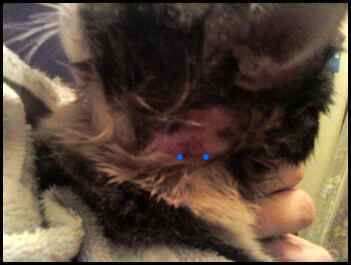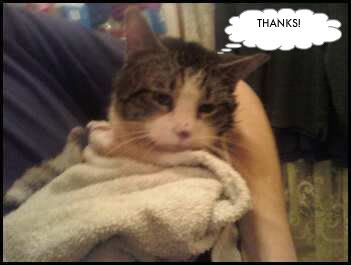I have been working part-time in an animal pound for over five years. In that time I have seen the aftermaths of some terrible injuries inflicted on both cats and dogs. However, my experience in treating animals only extends as far as removing ticks and administering medications. In my tenure at the pound, any major medical issues have been handled by animal medical care professionals.
On Saturday, my wife received a phone call from my mother. My parents' cat Patch had an abscess on his head and they didn't know what to do. An abscess forms when the skin is wounded and infected by a foreign object. At times, the foreign object is absorbed by abscess. The abscess fills with fluid and swells with great pressure, causing pain and discomfort to the victim. Left untreated, this fluid can poison the bloodstream, leading to death.
I called a more experienced colleague of mine for advice. What I was told was to take the cat to the veterinarian, where the vet would lance and then drain the abscess. Jokingly I asked if I could simply sterilize a razor blade and perform this procedure myself. This idea became less of a joke when it dawned on us that is was the weekend, and even if my parents wanted to go to the vet, it would prove difficult and costly (and hugely inconvenient, as my sister's birthday party was being thrown later that afternoon).
We arrived at my parents house with a syringe and antibiotic ointment. I was shocked when I first saw Patch. I was expecting something like a large pimple or wart on his face, but it looked as if someone had cut a baseball in half and implanted it in the side of his head. The abscess surrounded the area under his ear all the way down to below his jaw and all the way back to the top of his neck.
In my parents' bathroom about fifteen minutes before the party was to begin, we prepped for surgery by cleaning the cat and sterilizing a single edge razor blade with alcohol and heat. My mother, wife and I were in the room, my mother holding the cat and my wife assisting me, about to make the incision. When I was about to start, before the blade had even touched his flesh, the cat let out a wail. This was, no doubt, due to the fact that he was wrapped in a towel (which served to incapacitate him), held upside-down and in great pain to begin with. The cry gave my mom (whose head was already turned away) a shudder, and she voiced her second thoughts. I asked her to leave the room because I knew she wouldn't be able to handle what was about to take place.
Eileen took over holding Patch in place and I was ready (as I ever would be) to make the incision. I was naively expecting the blade to penetrate the skin as a knife would a hot dog, but to my chagrin his leathery skin was about an eighth of an inch thick, which required a tiny sawing motion to get through. Below is a picture of the incision, which I have marked from end to end with blue dots. I apologize for the poor quality as all the photos in this post were taken with my cell phone.

When I finally broke all the way down through the flesh, the pressure of the swelling caused the abscess to drain, very quickly. This was easily the most difficult part of the procedure to handle because despite what I had been told and all the mental preparation I had done, I was not ready for this disgusting deluge. Instead of a creamy white pus (a la pimples) what we got was a muddy, grayish-brown, foul-smelling swill flowing in an urgent, all-of-a-sudden matter.
We moved the cat into the shower and began to massage the fluid out from all points where abscess had swelled. All told, there was probably about a cup and a half of this slurry when all was said and done. When we were satisfied that he was drained, we cleaned him and ourselves up and put patch in a makeshift recovery room (it's the laundry room, pictured below).

Draining the abscess was only step one. If any material from the abscess remains under the skin it can attach itself to the inside of the flesh, causing the abscess to reform. To prevent this, the wound must be irrigated (IE flushed out) with an antibiotic solution. We used a 50/50 solution of Betadine and water.
Later in the evening we began the first irrigation. By this time the initial shock of the first round of surgery had worn off and it felt like business as usual. Using a syringe, I injected about 3cc of the Betadine solution into the incision I had previously made. I massaged the solution around underneath the flesh, then extracted it with the syringe. After repeating this process we returned Patch to the recovery room.
A day went past and yesterday we carried out the irrigation procedure yet another time (we later found out this was unnecessary but will not do any harm).
We brought Patch some sausage and he ate it out of my hand, which is a promising sign. We wish Patchy the best of a speedy recovery but the hard part is definitely over.
